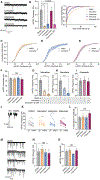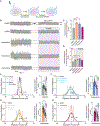Nano-organization of spontaneous GABAergic transmission directs its autonomous function in neuronal signaling
- PMID: 35947950
- PMCID: PMC9392417
- DOI: 10.1016/j.celrep.2022.111172
Nano-organization of spontaneous GABAergic transmission directs its autonomous function in neuronal signaling
Abstract
Earlier studies delineated the precise arrangement of proteins that drive neurotransmitter release and postsynaptic signaling at excitatory synapses. However, spatial organization of neurotransmission at inhibitory synapses remains unclear. Here, we took advantage of the molecularly specific interaction of antimalarial artemisinins and the inhibitory synapse scaffold protein, gephyrin, to probe the functional organization of gamma-aminobutyric acid A receptor (GABAAR)-mediated neurotransmission in central synapses. Short-term application of artemisinins severely contracts the size and density of gephyrin and GABAaR γ2 subunit clusters. This size contraction elicits a neuronal activity-independent increase in Bdnf expression due to a specific reduction in GABAergic spontaneous, but not evoked, neurotransmission. The same functional effect could be mimicked by disruption of microtubules that link gephyrin to the neuronal cytoskeleton. These results suggest that the GABAergic postsynaptic apparatus possesses a concentric center-surround organization, where the periphery of gephyrin clusters selectively maintains spontaneous GABAergic neurotransmission facilitating its autonomous function regulating Bdnf expression.
Keywords: CP: Neuroscience; GABAergic transmission; artemisinin; spontaneous neurotransmission; super resolution imaging; synapse nanostructure; synaptic transmission.
Copyright © 2022 The Author(s). Published by Elsevier Inc. All rights reserved.
Conflict of interest statement
Declaration of interests The authors declare no competing interests.
Figures







Similar articles
-
Depolarizing, inhibitory GABA type A receptor activity regulates GABAergic synapse plasticity via ERK and BDNF signaling.Neuropharmacology. 2018 Jan;128:324-339. doi: 10.1016/j.neuropharm.2017.10.022. Epub 2017 Oct 23. Neuropharmacology. 2018. PMID: 29074304 Free PMC article.
-
Gephyrin promotes autonomous assembly and synaptic localization of GABAergic postsynaptic components without presynaptic GABA release.Proc Natl Acad Sci U S A. 2024 Jun 25;121(26):e2315100121. doi: 10.1073/pnas.2315100121. Epub 2024 Jun 18. Proc Natl Acad Sci U S A. 2024. PMID: 38889143 Free PMC article.
-
Artemisinin-treatment in pre-symptomatic APP-PS1 mice increases gephyrin phosphorylation at Ser270: a modification regulating postsynaptic GABAAR density.Biol Chem. 2021 Apr 20;403(1):73-87. doi: 10.1515/hsz-2021-0153. Print 2022 Jan 26. Biol Chem. 2021. PMID: 33878252
-
Postsynaptic plasticity of GABAergic synapses.Neuropharmacology. 2020 Jun 1;169:107643. doi: 10.1016/j.neuropharm.2019.05.020. Epub 2019 May 17. Neuropharmacology. 2020. PMID: 31108109 Review.
-
Intracellular signaling mechanisms that shape postsynaptic GABAergic synapses.Curr Opin Neurobiol. 2023 Aug;81:102728. doi: 10.1016/j.conb.2023.102728. Epub 2023 May 24. Curr Opin Neurobiol. 2023. PMID: 37236068 Review.
Cited by
-
Chronic modulation of cAMP signaling elicits synaptic scaling irrespective of activity.iScience. 2024 Jun 5;27(7):110176. doi: 10.1016/j.isci.2024.110176. eCollection 2024 Jul 19. iScience. 2024. PMID: 38989459 Free PMC article.
-
Release your inhibitions: The cell biology of GABAergic postsynaptic plasticity.Curr Opin Neurobiol. 2025 Feb;90:102952. doi: 10.1016/j.conb.2024.102952. Epub 2024 Dec 25. Curr Opin Neurobiol. 2025. PMID: 39721557 Review.
-
Artemisinin exerts a protective effect in the MPTP mouse model of Parkinson's disease by inhibiting microglial activation via the TLR4/Myd88/NF-KB pathway.CNS Neurosci Ther. 2023 Apr;29(4):1012-1023. doi: 10.1111/cns.14063. Epub 2023 Jan 24. CNS Neurosci Ther. 2023. PMID: 36691817 Free PMC article.
-
Brain-derived neurotrophic factor scales presynaptic calcium transients to modulate excitatory neurotransmission.Proc Natl Acad Sci U S A. 2024 Apr 23;121(17):e2303664121. doi: 10.1073/pnas.2303664121. Epub 2024 Apr 15. Proc Natl Acad Sci U S A. 2024. PMID: 38621124 Free PMC article.
-
Spatially non-overlapping Ca2+ signals drive distinct forms of neurotransmission.Cell Rep. 2023 Oct 31;42(10):113201. doi: 10.1016/j.celrep.2023.113201. Epub 2023 Sep 30. Cell Rep. 2023. PMID: 37777959 Free PMC article.
References
Publication types
MeSH terms
Substances
Grants and funding
LinkOut - more resources
Full Text Sources
Miscellaneous

